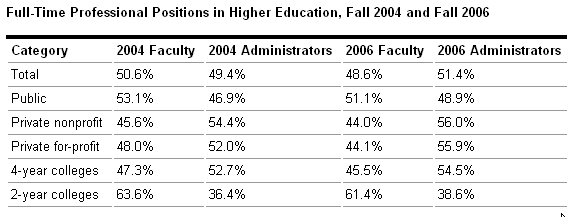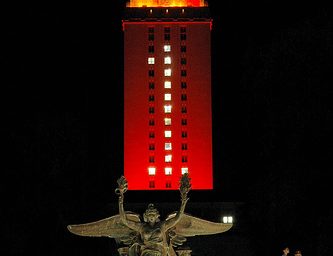University Administrators Outnumber Faculty
For the first time in history, administrators outnumber faculty among the full-time employees of America’s colleges and universities.
In the fall of 2006, for which data were released Tuesday, 48.6 percent of professional, full-time jobs in higher education were held by faculty members.
Faculty jobs remain the majority among full-time positions at two-year colleges and in public higher education, but because there are far more full-time jobs at four-year institutions than at two-year institutions, the balance has tilted away from professorial positions. (Adding part-time positions would of course also swell the faculty ranks across sectors, but this data set focuses on full-time positions.)
This is a bizarre skewing of hiring priorities. It’s not surprising, though, given that colleges are increasingly run by professional education bureaucrats (“educrats,” in my coinage) who have degrees in higher education administration rather than by former professors who have worked their way up the ranks. Teaching has become an expense to be borne rather than the central mission of many institutions.
Many in the comment thread on the story point out, reasonably enough, that the need for administrators has increased in recent years owing to federal regulation, the increased reliance on grants for funding, and other developments. That’s no doubt true. But to the level where there are more people administering the university than serving its primordial mission?
As the last line in the excerpt above notes, part of the trend is the hiring of fewer full-time faculty. But that’s symptomatic of the educrat mindset: Teaching is a necessary expenditure but one that can be outsourced. In the traditional university, the professors are the institution. Adjuncts, while they may be outstanding teachers, are not invested in the long-term success of the college or university. But they work cheap. And they are much less likely to agitate for academic rigor and standards that make it harder to retain students or to generally resist the idea that the academy is just another business.
Via Steven Taylor‘s shared Google Reader feed







Both education and health care have been observed to be highly susceptible to Gammon’s Law—decreasing outputs per input—and much of that is due to increasing bureaucracy. That both fields are highly regulated and competition is limited might have something to do with it.
The beast must be slain.
I heartily agree, teaching doesn’t seem to be the primary mission anymore. Unfortunately for me I have a son who is a high school junior looking for a college. News like this is very discouraging.
I wonder if there are any institutions bucking the trend and working toward making teaching a priority.
Steve, any four-year college with no graduate program will have teaching as a priority, so just pick one of those.